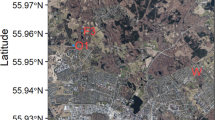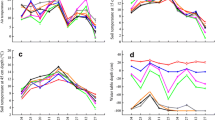Abstract
The Mer Bleue peatland is a large ombrotrophic bog with hummock-lawn microtopography, poor fen sections and beaver ponds at the margin. Average growing-season (May–October) fluxes of methane (CH4) measured in 2002–2003 across the bog ranged from less than 5 mg m−2 d−1 in hummocks, to greater than 100 mg m−2 d−1 in lawns and ponds. The average position of the water table explained about half of the variation in the season average CH4 fluxes, similar to that observed in many other peatlands in Canada and elsewhere. The flux varied most when the water table position ranged between −15 and −40 cm. To better establish the factors that influence this variability, we measured CH4 flux at approximately weekly intervals from May to November for 5 years (2004–2008) at 12 collars representing the water table and vegetation variations typical of the peatland. Over the snow-free season, peat temperature is the dominant correlate and the difference among the collars’ seasonal average CH4 flux is partially dependent on water table position. A third important correlate on CH4 flux is vegetation, particularly the presence of Eriophorum vaginatum, which increases CH4 flux, as well as differences in the potential of the peat profile to produce and consume CH4 under anaerobic and aerobic conditions. The combination of peat temperature and water table position with vegetation cover was able to explain approximately 44% of the variation in daily CH4 flux, based on 1097 individual measurements. There was considerable inter-annual variation in fluxes, associated with varying peat thermal and water table regimes in response to variations in weather, but also by variations in the water level in peripheral ponds, associated with beaver dam activity. Raised water level in the beaver ponds led to higher water tables and increased CH4 emission in the peatland.








Similar content being viewed by others
References
Baird AJ, Belyea LR, Morris PJ. 2009. Upscaling peatland-atmosphere fluxes of carbon gases: small-scale heterogeneity in process rates and the pitfalls of ‘bucket-and-slab’ models. In: Baird AJ, Belyea LR, Comas X, Reeve A, Slater L, Eds. Northern peatlands and carbon cycling. Washington DC, USA: American Geophysical Union. pp 37–54.
Bellisario LM, Bubier JL, Moore TR, Chanton JP. 1999. Controls on CH4 emissions from a northern peatland. Glob Biogeochem Cycles 13:81–91.
Billett MF, Moore TR. 2008. Supersaturation and evasion of CO2 and CH4 in surface waters at Mer Bleue peatland, Canada. Hydrol Proc 22:2044–54.
Bubier J. 1995. The relationship of vegetation to methane emission and hydrochemical gradients in northern peatlands. J Ecol 83:403–20.
Bubier J, Moore TR, Roulet NT. 1993. Methane emissions from wetlands in the boreal region of northern Ontario, Canada. Ecology 74:2240–54.
Bubier JL, Moore TR, Bellisario L, Comer N, Crill P. 1995. Ecological controls on methane emissions from a northern peatland complex in the zone of discontinuous permafrost, Manitoba, Canada. Glob Biogeochem Cycles 9:455–70.
Bubier J, Moore T, Savage K, Crill P. 2005. A comparison of methane flux in a boreal landscape between a dry and a wet year. Glob Biogeochem Cycles 19:GB1023. doi:10.1029/2004GB002351.
Bubier J, Moore TR, Crosby G. 2006. Fine-scale vegetation distribution in a cool temperate bog. Can J Bot 84:910–23.
Clymo RS, Reddaway EJF. 1971. Productivity of Sphagnum (bog-moss) and peat accumulation. Hydrobiologia 12:81–192.
Dalva M, Arp P, Moore TR, Clair TA. 2001. Methane and carbon dioxide emissions from wetlands, Kejimkujik National Park, Nova Scotia: measurements, predictions and climatic change. J Geophys Res 106:2955–2962.
Dise NB. 1992. Winter fluxes of methane from Minnesota peatlands. Biogeochem 17:71–83.
Dise NB, Gorham E, Verry ES. 1993. Environmental factors controlling methane emissions from peatlands in Northern Minnesota. J Geophys Res 98:10,583–94.
Dove A, Roulet N, Crill P, Chanton J, Bourbonniere R. 1999. Methane dynamics of a northern boreal beaver pond. Ecoscience 6:577–86.
Frolking S, Roulet NT. 2007. Holocene radiative forcing impact of northern peatland carbon accumulation and methane emissions. Glob Change Biol 13:1079–88.
Greenup AL, Bradford MA, McNamara MP, Ineson P, Lee JA. 2000. The role of Eriophorum vaginatum in CH4 flux from an ombrotrophic peatland. Plant Soil 227:265–72.
Harriss RC, Sebacher DI, Day FP. 1982. Methane flux in the Great Dismal Swamp. Nature 297:673–4.
Huttunen JT, Nykänen H, Turunen J, Martikainen PJ. 2003. Methane emissions from natural peatlands in the northern boreal zone in Finland, Fennoscandia. Atmospheric Environ 37:147–51.
ISI Web of Science. Topic = (methane flux OR methane emission OR methane exchange) AND Topic = (peatland* OR bog* OR fen* OR swamp* OR wetland*). Accessed 19-7-10.
Joabsson A, Christensen TR. 2001. Methane emissions from wetlands and their relationship with vascular plants: an Arctic example. Glob Change Biol 7:919–32.
Koelbener A, Ström L, Edwards PJ, Olde Venterink H. 2010. Plant species from mesotrophic wetlands cause relatively high methane emissions from peat soils. Plant Soil 326:147–58.
Liblik L, Moore TR, Bubier JL, Robinson SD. 1997. Methane emissions from wetlands in the zone of discontinuous permafrost: Fort Simpson, NWT, Canada. Glob Biogeochem Cycles 11:485–94.
Marinier M, Glatzel S, Moore TR. 2004. The role of cotton-grass (Eriophorum vaginatum) in CO2 and CH4 fluxes from restored peatlands, eastern Canada. Écoscience 11:141–9.
Melloh RA, Crill PM. 1996. Winter methane dynamics in a temperate peatland. Glob Biogeochem Cycles 10:247–54.
Moore TR, Dalva M. 1993. The influence of temperature and water table position on methane and carbon dioxide emissions from laboratory columns of peatland soils. J Soil Sci 44:651–64.
Moore TR, Dalva M. 1997. Methane and carbon dioxide exchange potentials of peat soils in aerobic and anaerobic laboratory incubations. Soil Biol Biochem 29:1157–64.
Moore TR, Heyes A, Roulet NT. 1994. Methane emissions from wetlands, southern Hudson Bay lowland. J Geophys Res 99:1455–68.
Moore T, Bubier J, Lafleur P, Frolking S, Roulet N. 2002. Plant biomass, production and CO2 exchange in an ombrotrophic bog. J Ecol 90:25–36.
Nisbet EG. 1989. Some northern sources of atmospheric methane: production, history, and future implications. Can J Earth Sci 26:1603–11.
Nykänen H, Alm J, Silvola J, Martikainen P. 1995. Fluxes of methane on boreal mires with different hydrology and fertility in Finland. In: Laiho R, Laine J, Vasander H, Eds. Northern peatlands in global climate change, proceedings of the international workshop held in Hyytiälä, Finland. Helsinki: Academy of Finland. p 127–35.
Pelletier L, Moore TR, Roulet NT, Garneau M, Beaulieu-Audy V. 2007. Methane fluxes from three peatlands in the La Grande Rivière watershed, James Bay lowland, Canada. J Geophys Res Biogeosci 112:G01018. doi:10.1029/2006JG000216.
Roulet NT, Ash R, Moore TR. 1992. Low boreal wetlands as a source of atmospheric methane. J Geophys Res 97:3739–49.
Roulet NT, Lafleur PM, Richard PJH, Moore TR, Humphreys ER, Bubier JL. 2007. Contemporary carbon balance and late Holocene carbon accumulation in a northern peatland. Glob Change Biol 13:397–411.
Rouse WR, Holland S, Moore TR. 1995. Methane emissions from wetlands in the Churchill region. Arct Alp Res 27:146–56.
Strack M, Waddington JM, Tuittila ES. 2004. Effect of water table drawdown on northern peatland methane dynamics: implications for climate change. Glob Biogeochem Cycles 18:GB4003. doi:10.1029/2003GB002209.
Ström L, Ekberg A, Mastepanov M, Christensen TR. 2003. The effect of vascular plants on carbon turnover and methane emissions from a tundra wetland. Glob Change Biol 9:1185–92.
Ström L, Mastepanov M, Christensen TR. 2005. Species-specific effects of vascular plants on carbon turnover and methane emissions from wetlands. Biogeochemistry 75:65–82.
Svensson BH. 1980. Carbon dioxide and methane fluxes from the ombrotrophic parts of a subarctic mire. Ecol Bull (Stockholm) 30:235–50.
Tokida T, Miyazaki T, Mizoguchi M, Nagata O, Takakai F, Kagemoto A, Hatano R. 2007. Falling atmospheric pressure as a trigger for methane ebullition from peatland. Glob Biogeochem Cycles 21:GB2003. doi:10.1029/2006GB002790.
Treat CC, Bubier JL, Varner RK, Crill PM. 2007. Timescale dependence of environmental and plant-mediated controls on CH4 flux in a temperate fen. J Geophys Res Biogeosci 112:G01014. doi:10.1029/2006JG000210.
Tuittila ES, Komulainen VM, Vasander H, Nykänen H, Martikainen PJ, Laine J. 2000. Methane dynamics of a restored cut-away peatland. Glob Change Biol 6:569–81.
Walter B, Heimann M. 2000. A process-based, climate-sensitive model to derive methane emissions from natural wetlands: application to five wetland sites, sensitivity to model parameters, and climate. Glob Biogeochem Cycles 14:745–65.
Whalen SC. 2005. Biogeochemistry of methane exchange between natural wetlands and the atmosphere. Environ Eng Sci 22:73–94.
Acknowledgements
We thank David Brodkey, Hélène Lesage, Michael Wironen, and especially Mike Dalva for their help in the field and laboratory, and Margaret Kalacska and Pablo Arroyo for estimating cotton grass coverage. We are grateful to the National Capital Commission for their logistic help and permission to use Mer Bleue and to the Associate Editor and an anonymous reviewer for their helpful comments. This work has been supported primarily by a grant from the Natural Sciences and Engineering Research Council of Canada (NSERC) and the Mer Bleue facility has also received support from NSERC, the Canadian Foundation for Climate and Atmospheric Sciences and BIOCAP Canada, through the Fluxnet Canada Research Network and the Canadian Carbon Program.
Author information
Authors and Affiliations
Corresponding author
Additional information
Author Contributions
TRM conceived and directed the study; ADY collected and analyzed much of the data; JLB, ERH, PML and NTR contributed data to the study and aided in the interpretation of the results; all six wrote the paper.
Rights and permissions
About this article
Cite this article
Moore, T.R., De Young, A., Bubier, J.L. et al. A Multi-Year Record of Methane Flux at the Mer Bleue Bog, Southern Canada. Ecosystems 14, 646–657 (2011). https://doi.org/10.1007/s10021-011-9435-9
Received:
Accepted:
Published:
Issue Date:
DOI: https://doi.org/10.1007/s10021-011-9435-9




